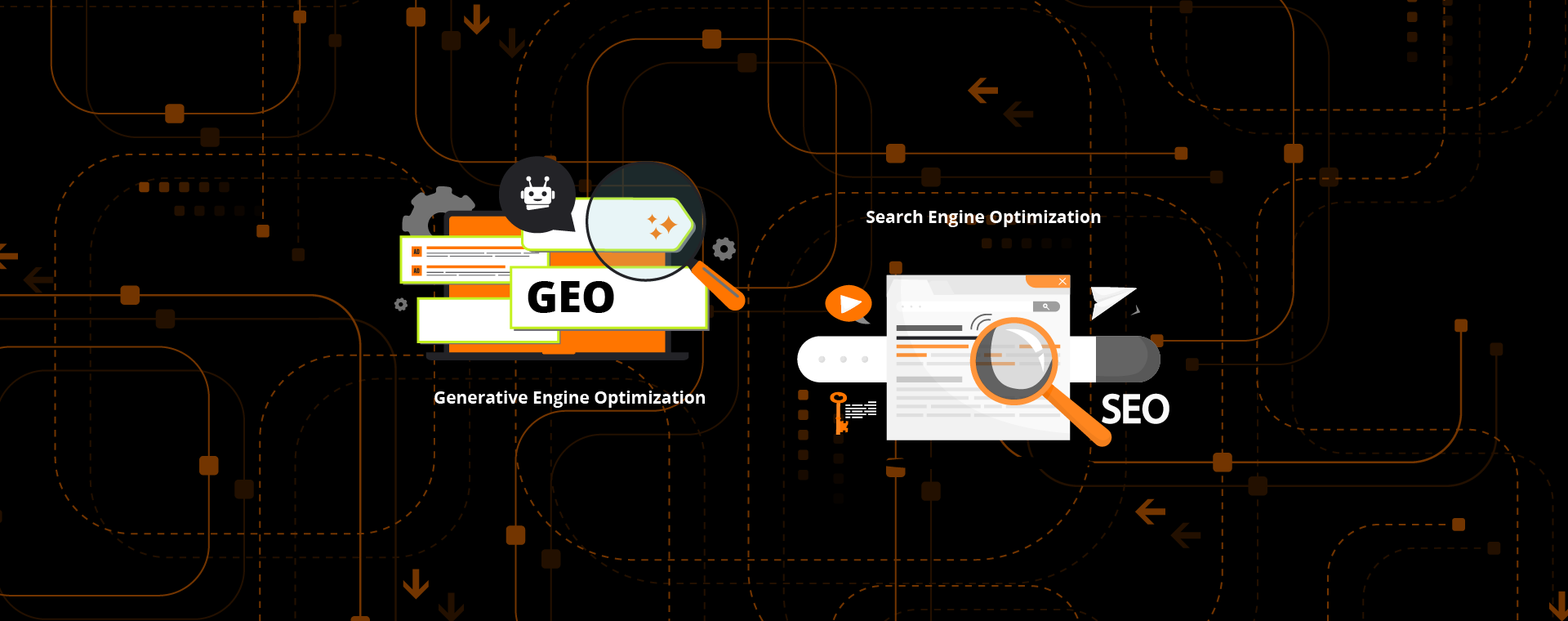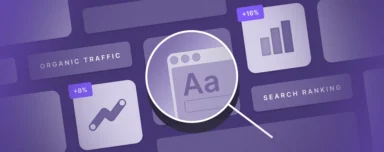GEO vs SEO: Understanding the Evolution of AI-Powered Search
The search landscape is experiencing its most dramatic transformation since Google’s inception. By 2026, Gartner predicts a 25% decline in traditional search volume as AI-powered platforms reshape how users discover information. This shift has given birth to generative engine optimization (GEO), a strategy that complements traditional search engine optimization (SEO) to maximize digital visibility across both human-driven and AI-driven search experiences.
Understanding the difference between GEO vs SEO isn’t academic; it’s essential for maintaining a competitive advantage in an evolving digital marketing landscape. While traditional SEO focuses on ranking websites in search engine results, GEO targets inclusion in AI-generated responses from platforms like ChatGPT, Google AI Overviews, and Perplexity.
This comprehensive guide explores both strategies, their unique approaches, and how strategic marketers are implementing integrated optimization tactics to future-proof their online visibility.
Key Takeaways
The evolution from traditional to AI-powered search optimization represents a fundamental shift in how content gets discovered and consumed online. Here are the essential insights every digital marketer needs to understand:
- GEO (Generative Engine Optimization) targets AI-powered search engines like ChatGPT, Google’s Search Generative Experience, and Perplexity, while SEO focuses on traditional search engines
- SEO aims to rank websites in search results pages, while GEO optimizes content to be featured in AI-generated responses and direct answers
- By 2026, Gartner predicts a 25% decline in traditional search volume, making GEO increasingly critical for maintaining website visibility
- Both strategies are complementary – GEO doesn’t replace SEO but works alongside traditional SEO practices to maximize reach across all search platforms
- Key GEO tactics include citation optimization, statistical integration, and structured content that AI systems can easily synthesize and reference
The rapid adoption of AI technology in search is undeniable. ChatGPT reached 100 million users in just two months, with no signs of slowing down. These statistics underscore the importance of understanding both SEO and GEO strategies for a comprehensive digital marketing strategy.
What is SEO (Search Engine Optimization)?
Search engine optimization remains the foundation of digital marketing strategy, focusing on improving a website’s visibility in traditional search engine results. SEO optimizes websites to rank higher in results from Google, Bing, and Yahoo through a combination of technical enhancements, content optimization, and authority building.
SEO encompasses several key components that work together to improve search rankings:
- Content and Keyword Strategy: Effective SEO relies on comprehensive keyword research to identify relevant keywords that match user intent. This involves creating high-quality content that addresses specific user queries while strategically incorporating targeted terms throughout the text, meta descriptions, and headers.
- Technical Optimization: The technical foundation includes optimizing load speed, ensuring mobile friendliness, implementing structured data markup, and creating XML sitemaps that help search engines crawl and index content effectively.
- Authority Building: SEO strategies focus on establishing domain authority by acquiring high-quality backlinks from reputable and credible sources, leveraging social signals, and demonstrating expertise through comprehensive topic coverage.
Success in traditional SEO methods is measured through established metrics, including organic traffic growth, click-through rates, search rankings improvement, and ultimately, conversion performance tracked through analytics platforms.
SEO Success Factors
SEO techniques have evolved significantly, but continue to rely on several fundamental pillars:
- Quality content addressing user search intent with comprehensive information that satisfies both search engines and human readers
- Strategic keyword placement in titles, headers, meta tags, and body content without compromising readability
- Technical performance optimization, including site speed, mobile responsiveness, and schema markup implementation
- Authority building through high-quality backlinks from reputable websites within relevant industries
- User experience signals like low bounce rates, high time-on-page metrics, and strong user engagement indicators
The E-E-A-T principles (Experience, Expertise, Authoritativeness, Trustworthiness) have become increasingly important as search engines prioritize content quality and source credibility in their ranking algorithms.
What is GEO (Generative Engine Optimization)?
Generative engine optimization represents a paradigm shift in how content gets discovered and presented to users. Rather than optimizing for search engine results, GEO focuses on positioning content to be referenced and cited within AI-generated responses from platforms like ChatGPT, Google AI Overviews, Perplexity, and BingChat.
GEO differs from traditional approaches because generative engines don’t simply rank pages; they synthesize information from multiple sources to create comprehensive answers. This means that optimizing content requires a fundamentally different approach, prioritizing citation-worthy information over SEO ranking factors.
The core elements of effective GEO strategies include:
- Citation-Ready Content Structure: AI engines prefer content that’s clearly structured with logical flow, authoritative citations, and easily extractable information. This means organizing content with clear headings, relevant data points, and explicit source attribution.
- Statistical Integration: AI systems often reference current and accurate statistics when generating responses. Including relevant statistics and quantifiable data significantly increases the likelihood of citation in AI-generated results.
- Authoritative Source Positioning: GEO content must establish clear expertise through credible citations, up-to-date information, and comprehensive topic coverage, positioning the content as a reliable reference source.
- Entity Optimization: AI systems understand relationships between concepts, people, places, and topics. Optimizing content for entity recognition enables AI engines to interpret and reference information within relevant contexts accurately.
GEO Success Factors
Success in generative engine optimization requires a different mindset and measurement approach:
- Authoritative citations from credible sources that AI systems can verify and reference in their responses
- Statistical data integration with current, accurate numbers that support content claims and provide quantifiable insights
- Clear, conversational language that AI can easily parse, understand, and synthesize for user queries
- Structured content with logical flow that addresses comprehensive topic coverage without gaps or inconsistencies
- Entity optimization helps AI understand relationships between concepts, topics, and authoritative sources
Unlike SEO metrics focused on traffic and rankings, GEO success is measured through citation frequency, brand mentions in AI responses, and content inclusion in synthesized answers.
How SEO and GEO Target Different Search Behaviors
The fundamental difference between GEO vs SEO lies in how they address distinct user search behaviors and expectations. SEO targets users who expect to click through to websites for detailed information, while GEO addresses the growing trend of users seeking immediate, comprehensive answers without leaving the search interface.
Traditional Search Behavior: Users typically enter queries expecting a list of relevant websites to explore. They’re willing to click through multiple results, compare information, and engage with specific websites to complete their research or purchase journey. This behavior supports the traditional digital marketing funnel, where website traffic converts to leads and sales.
AI-Driven Search Behavior: Modern users increasingly expect direct answers to their questions. When using AI-powered search engines, they want synthesized information that combines insights from multiple sources without the need to visit individual websites. This represents a shift toward zero-click searches, where value is delivered immediately.
Consider these behavioral indicators:
- In 2023, a Gartner study reported that 79% of consumers plan to use AI-enhanced search within the next year, indicating massive adoption of AI-driven search platforms
- ChatGPT reached 100 million users in just 2 months, demonstrating unprecedented adoption speed for AI search tools
- Google’s Search Generative Experience now appears for millions of queries, fundamentally changing user expectations for search results
This behavioral shift doesn’t eliminate the need for traditional SEO; rather, it creates demand for integrated strategies that capture value across both search paradigms.
The Zero-Click Trend
The rise of zero-click searches represents one of the most significant challenges and opportunities in modern search optimization. AI-generated responses often provide users with sufficient information to answer their queries without requiring website visits, fundamentally changing how content creators must think about value delivery.
However, this doesn’t mean reduced brand value. Content that gets cited in AI responses can build authority, trust, and brand recognition even without direct traffic. The key is to optimize content so that it is both citable by AI systems and compelling enough to drive engagement when users do click through.
Key Differences in Optimization Strategies
Understanding the strategic differences between traditional SEO and GEO is crucial for developing effective integrated approaches. While both strategies share some foundational elements, their tactical implementations and success metrics diverge significantly.
| Aspect | SEO | GEO |
| Target Platform | Traditional search engines (Google, Bing) | AI-driven search engines (ChatGPT, SGE, Perplexity) |
| Primary Goal | Rank website pages, maximize organic site traffic | Get content cited/referenced in AI-generated responses |
| Optimization Focus | Relevant keywords, links, technical SEO, and search intent | Structured data, clear citations, factual/statistical integration |
| Success Measurement | Organic traffic, click-through rate, rankings, conversions | Citation frequency, impression metrics in AI responses, and brand mentions |
| Content Structure | Long-form, intent-driven, optimized for both bots and humans | Scannable, precise, structured for AI parsing and synthesis |
| User Action Goal | Click through to the website for deeper engagement | Immediate answer consumption in AI result interface |
These differences highlight why both SEO and GEO require distinct tactical approaches while supporting complementary strategic objectives.
SEO Success Factors
Traditional search engine optimization continues to rely on well-established best practices that have proven effective over decades:
- Content Quality and Relevance: SEO focuses on creating high-quality content that thoroughly addresses users’ intent while incorporating relevant keywords naturally throughout the text. This includes optimizing titles, meta descriptions, and headers to match search queries.
- Technical FoundatiUser Experience Optimization: Modern SEO strategies prioritize user engagement metrics, including reduced bounce rates, increased time-on-page, and strong click-through rates that signal content quality to search algorithms.
GEO Success Factors
Generative engine optimization requires a fundamentally different approach that prioritizes AI comprehension and citation-worthiness:
- Citation-Ready Authority: GEO content must include authoritative and credible sources that AI systems can verify and reference. This means incorporating explicit citations, up-to-date research, and clearly attributed information.
- Statistical Integration: AI engines frequently reference quantifiable data when generating responses. Including relevant statistics, current research findings, and measurable insights significantly increases citation probability.
- Structured Information Architecture: GEO targets a clear, logical content structure that AI systems can easily parse and synthesize. This includes using descriptive headers, logical topic progression, and explicit connections between related concepts.
- Entity Relationship Optimization: Effective GEO strategies help AI systems understand relationships between people, places, concepts, and topics through clear entity references and contextual connections.
The success of GEO strategies is measured through different metrics than traditional SEO, focusing on citation frequency and inclusion in AI-generated responses rather than traffic and rankings.
Measuring Success: SEO vs GEO Metrics
The measurement approaches for SEO and GEO reflect their different objectives and user interactions. Traditional SEO metrics focus on traffic generation and user engagement, while GEO metrics emphasize citation visibility and brand presence in AI-generated content.
SEO Measurement Approaches
Traditional search engine optimization relies on established analytics frameworks that track user acquisition, engagement, and conversion:
- Traffic and Visibility Metrics: Organic traffic growth, search rankings for target keywords, impression metrics in search results, and click-through rates from search engine results pages provide core performance indicators.
- Engagement and Quality Signals: User behavior metrics, including bounce rates, time-on-page, pages per session, and conversion rates, help measure content quality and user satisfaction.
- Authority and Technical Performance: Domain authority improvements, backlink acquisition rates, page load speeds, and technical SEO compliance scores indicate overall optimization effectiveness.
These metrics are well-supported by mature analytics tools, including Google Analytics, Google Search Console, and numerous third-party SEO platforms that provide comprehensive performance tracking.
GEO Measurement Challenges and Solutions
Measuring generative engine optimization success requires new approaches and emerging tools explicitly designed for AI-powered search environments:
- Citation and Mention Tracking: The primary GEO success metric involves tracking how frequently content gets cited or referenced in AI-generated responses across platforms like ChatGPT, Perplexity, and Google’s Search Generative Experience.
- Impression Metrics in AI Responses: Unlike traditional search, where impressions are easily tracked, GEO requires monitoring content appearance in AI-synthesized answers, which often happens without direct attribution or tracking capabilities.
- Brand Visibility in AI Outputs: Measuring brand mentions and authority recognition within AI-generated content provides insight into how effectively content establishes thought leadership and expertise.
Tools like HubSpot’s AI Search Grader have emerged to help measure GEO performance, though the measurement ecosystem remains less mature than traditional SEO analytics. As the field develops, more sophisticated tracking and attribution tools will likely emerge to support comprehensive GEO measurement.
The Complementary Relationship Between SEO and GEO
Rather than competing strategies, SEO and GEO work synergistically to maximize digital visibility across the entire search ecosystem. Understanding their complementary nature is essential for developing comprehensive optimization strategies that capture value from both traditional and AI-powered search platforms.
- Shared Foundation Elements: Both SEO and GEO benefit from high-quality content creation, authoritative source citations, structured data implementation, and comprehensive topic coverage. These foundational elements support success in both optimization approaches.
- Technical Synergies: Technical SEO improvements, including structured data markup, site speed optimization, and mobile friendliness, benefit both traditional search rankings and AI content parsing capabilities. Investment in technical infrastructure supports both strategies simultaneously.
- Authority Building Overlap: Content that builds authority for traditional SEO—through expert insights, comprehensive research, and credible citations—also enhances credibility for AI citation purposes. Authority signals translate effectively across both optimization approaches.
- Content Quality Benefits: The emphasis on creating relevant content that serves user intent supports both click-through engagement (SEO) and citation-worthy information (GEO). Quality content naturally satisfies both optimization requirements.
Implementation Strategies for Both SEO and GEO
Developing practical implementation strategies for both SEO and GEO requires understanding how to layer optimization techniques effectively while managing resource allocation across both approaches.
Strategic Integration Approaches
Successful integration of both SEO and GEO requires strategic planning that maximizes overlap while addressing unique requirements:
- Content Enhancement Strategy: Start with high-performing SEO content and enhance it with GEO elements, including authoritative citations, relevant statistics, and structured information that AI systems can easily reference.
- Dual-Purpose Content Creation: Develop content creation processes that simultaneously address traditional keyword targeting and AI synthesis requirements through comprehensive topic coverage and clear information architecture.
- Measurement Integration: Implement analytics approaches that track both traditional SEO metrics (traffic, rankings) and emerging GEO indicators (citations, AI mentions) to understand comprehensive optimization performance.
Starting with SEO Foundations
Traditional SEO practices provide the technical and content foundation that supports effective GEO implementation:
- Technical Infrastructure: Ensure robust technical SEO, including fast load speeds, mobile friendliness, secure HTTPS implementation, and comprehensive structured data markup. These technical elements benefit both search engine crawling and AI content parsing.
- Content Strategy Development: Begin with thorough keyword research to understand user intent and search behavior. Create high-quality content that addresses user queries comprehensively while establishing topical authority and expertise.
- Authority Building: Focus on building domain authority through high-quality backlinks, expert content creation, and establishing clear E-E-A-T signals that demonstrate expertise, experience, authoritativeness, and trustworthiness.
Layering GEO Enhancements
Once solid SEO foundations are established, layer GEO-specific optimizations that enhance AI citation potential:
- Citation Integration: Add authoritative and credible sources to existing content, ensuring proper attribution and current information that AI systems can verify and reference in responses.
- Statistical Enhancement: Incorporate relevant data points, current research findings, and quantifiable insights that provide concrete information for AI synthesis and user value.
- Structure Optimization: Reorganize content with clear headings, logical flow, and explicit topic connections that help AI systems understand and extract relevant information effectively.
- Entity Optimization: Ensure clear entity references, including people, places, organizations, and concepts that help AI systems understand content context and relationships.
Integrated Content Creation Workflows
Develop content creation processes that simultaneously address both SEO and GEO requirements:
- Topic Research and Planning: Use keyword research to identify user intent while also considering what questions AI systems might synthesize answers for. Focus on comprehensive topic coverage that serves both objectives.
- Content Structure and Writing: Create content with a clear hierarchical structure, descriptive headers, and logical progression that serves both human readers and AI parsing requirements.
- Citation and Data Integration: Include authoritative sources and relevant statistics naturally within content flow, ensuring information adds value for readers while providing citation-worthy references for AI systems.
- Optimization and Enhancement: Review content for both traditional SEO elements (keyword placement, meta descriptions) and GEO requirements (citation clarity, statistical accuracy, structural logic).
Performance Monitoring and Iteration
Implement measurement approaches that track success across both optimization strategies:
- Comprehensive Analytics: Use traditional SEO tools (Google Analytics, Search Console) alongside emerging GEO measurement tools to understand performance across both search paradigms.
- Content Performance Analysis: Regularly analyze which content performs well in traditional search rankings and AI citations to identify successful optimization patterns.
- Strategy Refinement: Continuously refine approaches based on performance data, algorithm updates, and emerging best practices in both SEO and GEO optimization.
Future Outlook: The Evolution of Search Optimization
The search optimization landscape is experiencing unprecedented change as AI technology reshapes how users discover and consume information. Understanding future trends and preparing for continued evolution is essential for maintaining a competitive advantage in digital marketing.
AI Adoption and Market Transformation
The statistics surrounding AI adoption in search reveal the magnitude of this transformation:
- Rapid User Adoption: AI-powered search tools have achieved remarkable adoption rates, with ChatGPT reaching 100 million users in just two months: one of the fastest technology adoption curves in history.
- Business Integration: Approximately 65% of organizations now regularly use generative AI, nearly doubling adoption rates in less than a year. This business adoption drives demand for AI-compatible content and optimization strategies.
- Consumer Behavior Shift: A 2023 Gartner study indicated that 79% of consumers planned to use AI-enhanced search within the next year, suggesting mainstream adoption of AI-driven search behaviors.
- Market Prediction: Gartner’s prediction of a 25% decline in traditional search volume by 2026 underscores the need for developing integrated optimization strategies that address both current and future search paradigms.
Technology Evolution and Platform Development
The continued evolution of AI search technology will likely bring new optimization opportunities and challenges:
- Platform Maturation: As AI search platforms mature, they’re developing more sophisticated citation systems, real-time web crawling capabilities, and improved accuracy in source attribution, creating new opportunities for content visibility.
- Hybrid Search Models: Future search experiences will likely blend traditional result listings with AI-generated answers, requiring optimization strategies that succeed across multiple presentation formats.
- Multimodal Search Integration: The integration of voice, image, and video search capabilities with AI-powered synthesis will expand optimization requirements beyond traditional text-based content.
Strategic Recommendations for Future-Proofing
Organizations that adapt early to integrated SEO and GEO strategies will maintain significant competitive advantages:
- Develop Dual Competencies: Build internal expertise in both traditional SEO practices and emerging GEO techniques to ensure comprehensive optimization capabilities as the market evolves.
- Invest in Quality and Authority: Focus on creating high-quality content with strong authoritative foundations that perform well across both traditional and AI-powered search environments.
- Embrace Measurement Evolution: Adopt emerging analytics tools and metrics that track performance across both traditional search rankings and AI citation frequency to understand comprehensive optimization effectiveness.
- Maintain Strategic Flexibility: Stay informed about technological developments and be prepared to adapt optimization strategies as AI search technology and user behaviors continue evolving.
The future of search optimization belongs to marketers who understand that traditional SEO practices provide essential foundations while GEO strategies address emerging user behaviors and technological capabilities. Success requires mastering both approaches and developing integrated strategies that maximize visibility across the complete search ecosystem.
Frequently Asked Questions – FAQ
What is the main difference between GEO and SEO? SEO optimizes content to rank higher in traditional search engine results pages using relevant keywords, backlinks, and technical optimization. GEO targets AI-powered search engines to appear in AI-generated responses using citations, structured data, and comprehensive topic coverage. SEO focuses on driving website traffic through click-throughs, while GEO aims for brand mentions and information inclusion in direct AI answers. Both serve different but complementary roles in a comprehensive digital marketing strategy.
Is GEO replacing SEO completely? No, SEO is alive and well. GEO complements traditional SEO rather than replacing it entirely. Traditional search engines remain crucial for organic traffic generation and website visibility, especially for transactional queries and detailed research needs. Users still click through to websites for comprehensive information, product purchases, and deeper engagement. SEO remains crucial for building domain authority, technical performance, and user experience that supports overall digital marketing objectives. Integrated strategies that combine both SEO and GEO provide the most comprehensive search optimization coverage.
How do I measure GEO success for my website? Track citation visibility and brand mentions in AI-generated responses across platforms like ChatGPT, Google AI Overviews, and Perplexity. Use emerging tools like HubSpot’s AI Search Grader to analyze performance in AI-powered search engines and monitor impression metrics showing how often content appears in AI answers. Measure relevance scores for queries related to your industry expertise and track authority recognition within synthesized responses. While GEO measurement tools are still developing, focus on citation frequency and quality of AI mentions as primary success indicators.
What are the most effective GEO tactics to implement? Add authoritative and credible sources with clear citations to boost content trustworthiness and provide AI systems with verifiable references. Integrate relevant statistics and current data points that AI systems can reference when generating responses. Structure content with clear headings, logical flow, and comprehensive topic coverage that helps AI understand and synthesize information effectively. Focus on entity optimization by clearly defining relationships between concepts, people, and topics. Ensure content provides direct answers to common user queries while maintaining accuracy and authority.
Can small businesses benefit from both SEO and GEO? Yes, both strategies are scalable and beneficial for businesses of all sizes. Start with strong traditional SEO practices, including local optimization, quality content creation, and basic technical improvements. Gradually incorporate GEO elements like authoritative citations, relevant statistics, and structured content organization. Focus on comprehensive topic coverage within your industry expertise to serve both traditional search rankings and AI citation purposes. Small businesses can often achieve better results by focusing on specific niches where they can establish clear authority and expertise across both optimization approaches.
Final Thoughts
The evolution from traditional to AI-powered search optimization represents more than a technological shift—it’s a fundamental change in how users discover and consume information online. Understanding GEO vs SEO isn’t about choosing between strategies; it’s about developing integrated approaches that maximize visibility across the complete search ecosystem.
As AI technology continues to reshape search behaviors, the organizations that thrive will be those that master both traditional SEO practices and emerging GEO techniques. The 25% predicted decline in traditional search volume by 2026 doesn’t eliminate the need for SEO—it emphasizes the importance of developing comprehensive strategies that capture value from both human-driven and AI-driven search experiences.
The future belongs to marketers who understand that high-quality content, authoritative citations, and strategic optimization serve users effectively regardless of whether they discover information through traditional search rankings or AI-generated responses. By building on solid SEO foundations while embracing GEO innovations, businesses can future-proof their digital marketing strategies and maintain a competitive advantage in an evolving landscape.
Start by auditing your current SEO performance, then systematically enhance your best content with GEO elements, including authoritative citations, relevant statistics, and structured information that AI systems can easily reference. The intersection of traditional and AI-powered search optimization represents the next frontier in digital marketing, and early adopters will capture the greatest rewards.






